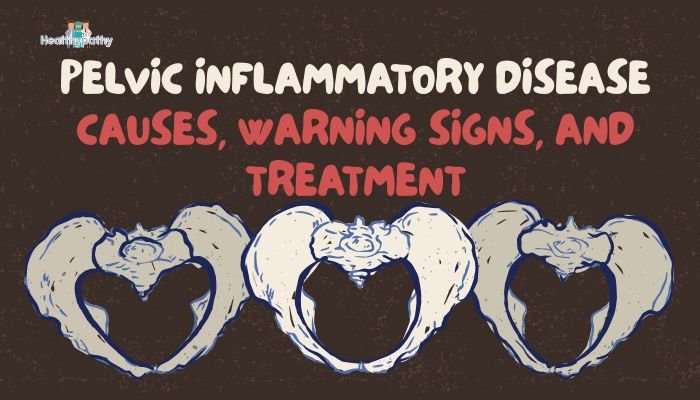Introduction
Pelvic Inflammatory Disease (PID) is an infection of the female reproductive organs, typically involving the uterus, fallopian tubes, and ovaries. It often develops from sexually transmitted infections (STIs) like chlamydia or gonorrhea but can also arise from other infections. PID can lead to serious complications—such as infertility or chronic pelvic pain—if untreated. Understanding its causes, recognizing early signs, and seeking prompt treatment remain central to protecting reproductive health.
Understanding Pelvic Inflammatory Disease
How PID Develops
PID commonly begins when bacteria ascend from the vagina or cervix into the uterus, fallopian tubes, or ovaries. Common routes include:
- Untreated STIs: Most frequently, gonorrhea or chlamydia.
- Bacterial Vaginosis or Other Infections: Pathogens can travel upwards if protective vaginal flora or cervical barriers are compromised.
- Gynecological Procedures: Rarely, instrumentation (like IUD insertion, childbirth, miscarriage management, or endometrial biopsy) can introduce bacteria into the upper reproductive tract.
Once inside these organs, bacteria trigger inflammation and, if not addressed, can lead to scarring, abscess formation, and fertility threats.
Who’s Most at Risk
Certain factors raise the likelihood of PID:
- Sexually Active Under 25: Higher STI incidence in younger populations.
- Multiple or New Sexual Partners: Increases exposure risk to potential pathogens.
- Previous PID or STIs: Each episode can predispose further infections or complications.
- Douching: Disrupts protective vaginal flora, potentially pushing bacteria upward.
Understanding and managing these risks can help reduce PID’s prevalence and severity.
Warning Signs and Symptoms
Common Symptoms
While PID may present subtly, typical indications include:
- Lower Abdominal or Pelvic Pain: Often dull, persistent, and worsened by intercourse or certain movements.
- Abnormal Vaginal Discharge: Possibly yellowish, greenish, or foul-smelling.
- Painful Urination: Can occur if infection irritates the urethra or bladder.
- Fever and Chills: Signaling a spreading infection.
- Irregular Menstrual Bleeding: Spotting between periods or heavier-than-usual bleeding.
Asymptomatic or Mild Cases
Some women have minimal or no early symptoms, delaying diagnosis. This underscores the importance of routine STI testing and prompt evaluation of any changes in discharge, pain, or cycle irregularities.
Potential Complications if Untreated
Chronic Pelvic Pain
PID-induced inflammation and scarring can result in ongoing pelvic or lower abdominal discomfort, impacting daily life and sexual activity.
Infertility and Ectopic Pregnancy
Scarring or blockage within the fallopian tubes may prevent fertilized eggs from reaching the uterus. This raises the chance of ectopic pregnancy, a serious condition where the embryo implants in the tube.
Abscess Formation
In some cases, pus-filled pockets (tubo-ovarian abscesses) develop within the fallopian tubes or ovaries. These may require intensive antibiotic therapy or surgical intervention if they rupture.
Diagnosis and Evaluation
Medical History and Physical Exam
Clinicians review symptoms, sexual history, and STI risks. A pelvic exam checks for cervical motion tenderness, uterine tenderness, or adnexal (area around ovaries/tubes) tenderness—often referred to as the “chandelier sign.”
Laboratory Tests
- STI Testing: Swabs or urine tests for gonorrhea, chlamydia, or other pathogens.
- Blood Work: Elevated inflammatory markers (like ESR or CRP) might indicate infection.
- Pregnancy Test: Rules out or identifies possible ectopic pregnancy.
Imaging
Ultrasound can show thickened or fluid-filled fallopian tubes and help detect abscesses or abnormal fluid collections. In complex situations, more detailed imaging (like MRI) is occasionally necessary.
Treatment Options
Antibiotic Therapy
Early antibiotic intervention is vital for preventing complications. Standard regimens often cover gonorrhea, chlamydia, and anaerobic bacteria. Treatment can involve:
- Oral Antibiotics: For mild to moderate PID, often combining two or more drugs.
- IV Antibiotics: In severe cases or if outpatient therapy fails.
- Follow-Up Testing: Ensures the infection resolves fully, sometimes repeated imaging if abscess suspected.
Hospitalization or Surgery
Admittance may be required if there’s significant pain, fever, or suspicion of a large abscess or ectopic pregnancy. Rarely, surgical drainage or removal of damaged organs is needed for advanced or complicated infections.
Partner Notification and Treatment
Sexual partners should undergo evaluation and, if infected, receive antibiotics to prevent reinfection or further spread. Refraining from intercourse until the infection clears lowers recurrence risk.
Preventing PID
Practicing Safe Sex
- Condom Use: Reduces the likelihood of STIs leading to PID.
- Regular STI Screenings: Particularly for sexually active young adults or those with multiple partners.
- Monogamy or Limit Partners: Less exposure lowers the probability of infection.
Avoid Douching
Douching disrupts vaginal flora, allowing potentially harmful bacteria to ascend into the uterus. Healthcare providers strongly discourage the practice.
Prompt STI Treatment
Untreated gonorrhea or chlamydia often initiates PID. Seeking timely antibiotic therapy for STIs helps prevent bacterial spread to the upper reproductive tract.
Risk Awareness with IUDs
While IUDs are safe for most, insertion might pose a slight infection risk if not done under sterile conditions or if an undiagnosed STI is present. Pre-insertion STI screening or prophylactic antibiotics (in some guidelines) helps mitigate this risk.
Moving Forward: Awareness and Maintenance
Watch for Early Signs
If you notice persistent pelvic pain, abnormal discharge, or fever, consult a healthcare provider. Early detection ensures simpler treatment and fewer long-term consequences.
Keep Routine Checkups
Regular gynecological exams and pap smears facilitate early detection of changes that might predispose you to infection or complications. Discuss any concerns about unusual discharge or chronic pain with your doctor.
Communication with Partners
Openly discussing STI risks and testing fosters an environment where both partners can maintain sexual health. Ensuring partner treatment is essential in preventing reinfection cycles.
Conclusion
Pelvic Inflammatory Disease can be a serious threat to women’s reproductive health, especially if left untreated. Often stemming from untreated STIs like gonorrhea or chlamydia, PID can lead to chronic pain, infertility, and other complications down the road. Recognizing symptoms—pelvic pain, abnormal discharge, fever—and seeking timely antibiotic treatment can halt the infection before lasting damage occurs.
Staying vigilant about STI prevention, practicing safe sex, and responding promptly to signs of infection form the core of PID prevention. Through regular medical checkups, conscientious sexual health measures, and swift treatment of suspected issues, most women can avoid PID or manage it effectively to preserve their fertility and quality of life.
References
- https://www.cdc.gov
- Haggerty CL, Gottlieb SL, Taylor BD, Low N, Xu F, Ness RB. Risk of PID among women with prior STIs. J Infect Dis. 2019;215(S3):e41–e48.
- Ross J, et al. 2021 UK national guideline for the management of pelvic inflammatory disease. J Infect Dev Ctries. 2022;16(3):268–277.
- Brunham RC, Gottlieb SL, Paavonen J. Pelvic inflammatory disease. N Engl J Med. 2019;372(21):2039–2048.






